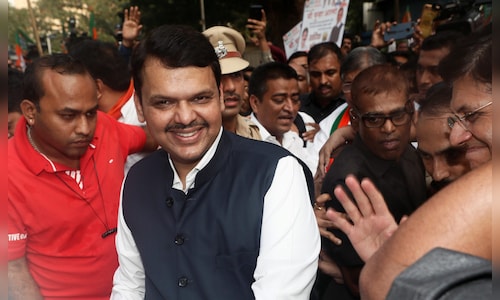
The Mahayuti is currently leading in approximately 219 seats in Maharashtra, solidifying its dominance in the state. Within this tally, the BJP leads in 124 constituencies, Shiv Sena (Shinde faction) in 55, and the NCP (Ajit Pawar faction) in 37. On the other hand, the Maha Vikas Aghadi (MVA) is ahead in 56 seats, with Shiv Sena (UBT) leading in 20, Congress in 19, and the Sharad Pawar-led NCP in 13 constituencies.
Meanwhile, in Jharkhand, the INDIA bloc is leading comfortably in 50 seats, while the NDA trails with a lead in 30 constituencies. These trends highlight contrasting political dynamics in the two states, with the Mahayuti consolidating its grip in Maharashtra and the INDIA bloc making significant strides in Jharkhand.
Maharashtra: Dominance of Mahayuti
The BJP-led Mahayuti alliance’s landslide victory in Maharashtra has solidified the BJP’s dominance in the state, marking a significant political milestone. Securing over 200 seats, the Mahayuti alliance has showcased its formidable organisational capabilities and effective campaign strategies. This victory is not just a testament to the BJP’s robust electoral machinery but also a reflection of its ability to resonate with the electorate through targeted messaging and strategic alliances.
The Mahayuti’s success can be attributed to several factors, including a well-coordinated campaign that emphasised development, governance, and stability. The alliance’s ability to address local issues while maintaining a cohesive narrative across the state played a crucial role in its sweeping victory. Additionally, the BJP’s strategic use of social media and grassroots mobilisation ensured a high voter turnout, further consolidating its position.
This victory not only ensures another term for the Mahayuti government but also strengthens the BJP’s position in the political landscape. It provides the party with a solid foundation to build upon, reinforcing its influence in one of India’s most politically significant states. The results in Maharashtra will likely have a ripple effect, boosting the BJP’s morale and strategic positioning on the national stage.
Jharkhand: JMM’s grounded mobilisation
In stark contrast to the BJP’s triumph in Maharashtra, the Jharkhand Mukti Morcha (JMM)-led INDIA bloc emerged as the real winner in Jharkhand. Hemant Soren’s leadership was pivotal, with his focus on local issues such as tribal rights and rural development resonating deeply with the electorate. Soren’s administration prioritised the needs of the state’s tribal population, implementing policies that directly addressed their concerns and aspirations.
One of the key factors in the JMM’s success was their effective grassroots mobilisation. Soren’s team worked tirelessly to engage with voters at the local level, ensuring that their campaign was grounded in the realities of everyday life in Jharkhand. This approach helped build a strong connection with the electorate, who felt that their voices were being heard and their issues addressed.
Welfare schemes like the Maiya Samman Yojana, which provided financial support to women from marginalised communities, played a crucial role in securing the JMM’s victory. These initiatives not only improved the lives of many Jharkhand residents but also demonstrated the JMM’s commitment to social justice and inclusive development.
Hemant Soren’s leadership, grounded mobilisation, and focus on local issues resonated deeply with the electorate, securing a decisive victory. The JMM’s success underscores the importance of addressing grassroots concerns and building strong local connections.
Meanwhile, the Congress party’s performance in both states has been disappointing, highlighting ongoing challenges in connecting with voters and presenting a compelling alternative to the BJP. The results raise questions about the Congress’s ability to lead a united front against the BJP, especially as regional parties like the JMM demonstrate their effectiveness.
These outcomes will undoubtedly shape the political landscape leading up to the 2024 general elections, emphasising the need for strategic alliances and strong local leadership.
Congress declines
Congress’s underwhelming performance in both Maharashtra and Jharkhand underscored its persistent challenges at the state level. In Maharashtra, despite expectations of a strong showing in Vidarbha, Congress failed to make a significant impact. Vidarbha, once seen as fertile ground for Congress due to agrarian distress and historical support, swung decisively towards the BJP-led Mahayuti.
Analysts pointed to Congress’s failure to connect with voters on local issues, poor grassroots mobilisation, and the lack of a compelling regional strategy. Within the Maha Vikas Aghadi (MVA), Congress appeared overshadowed by its allies and unable to leverage its position effectively. The party’s reliance on national narratives, like targeting the BJP for corruption and polarisation, failed to resonate with the state’s diverse electorate.
In Jharkhand, Congress’s presence in the winning INDIA alliance was largely carried by the JMM and its leader, Hemant Soren. The JMM dominated the campaign by focusing on local concerns such as tribal rights, employment, and rural development, while Congress remained peripheral in both messaging and execution. While Congress benefited from the alliance’s overall success, its inability to independently mobilise voters or influence key issues became apparent.
These results emphasise Congress’s structural weaknesses in state politics. To regain ground, Congress must prioritise grassroots mobilisation, develop strong regional leadership, and address specific local issues. National-level campaigns against the BJP, while effective in broad narratives, fall short in state contests where voters prioritise tangible, localised governance. Without strategic introspection and reform, Congress risks further decline in its role within opposition alliances and its overall relevance in Indian politics.
Impact on opposition unity and future political landscape
The results of the Maharashtra and Jharkhand assembly elections have significant implications for the broader opposition strategy in India. The Congress’s weak performance in both states raises questions about its ability to lead a united front against the BJP. In Maharashtra, the Congress struggled to maintain its foothold, securing only a fraction of the seats compared to the BJP-led Mahayuti alliance. Similarly, in Jharkhand, the Congress’s role within the INDIA bloc was overshadowed by the JMM’s strong performance. This decline highlights the party’s ongoing challenges in connecting with voters and presenting a compelling alternative to the BJP.
The success of the JMM in Jharkhand, however, demonstrates that regional parties with strong local leadership can effectively challenge the BJP’s dominance. Hemant Soren’s leadership and focus on local issues, such as tribal rights and rural development, resonated deeply with the electorate. The JMM’s effective grassroots mobilisation and welfare schemes, like the Maiya Samman Yojana, played a crucial role in securing their victory. This dynamic could influence future alliances and strategies within the opposition camp, emphasising the importance of addressing local issues and building strong grassroots support.
The assembly poll outcomes in Maharashtra and Jharkhand will shape the political landscape moving forward. The BJP’s strengthened position in Maharashtra provides a solid foundation for its national campaign. Meanwhile, the JMM’s victory in Jharkhand underscores the importance of addressing local issues and building strong grassroots support. For the Congress, these results serve as a wake-up call to reassess its strategies and leadership to remain relevant in the evolving political scenario.
— The author, Prof. Sayantan Ghosh (@sayantan_gh), is a political observer and columnist who teaches journalism at St. Xavier’s College, Kolkata. The views expressed are personal.
Read his previous articles here



